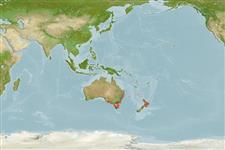Environment: milieu / climate zone / depth range / distribution range
Ökologie
seewasser; brackwasser benthopelagisch; tiefenbereich 0 - 20 m (Ref. 9002). Temperate; 25°S - 43°S, 135°E - 180°E
Western Pacific: southeastern Australia (southern Queensland to South Australia) and New Zealand.
Length at first maturity / Size / Gewicht / Alter
Maturity: Lm 29.5, range 22 - ? cm
Max length : 71.0 cm FL Männchen/unbestimmt; (Ref. 6390); common length : 35.0 cm TL Männchen/unbestimmt; (Ref. 2158); max. veröff. Gewicht: 4.0 kg (Ref. 6390); max. veröff. Alter: 24 Jahre (Ref. 95598)
Adults favor estuarine (including mangroves), rocky reef and inshore, coastal water habitats (Ref. 5962, 27248). They flourish in seagrass areas (Ref. 6390). Ludericks are moderately sedentary, schooling fish. They are herbivorous and feed primarily on seagrasses (Ref. 6390). Filamentous algae (Ref. 26966) and cabbage weed also form part of their diet (Ref. 28607). Marketed as fresh fish (Ref. 10384).
Maturing luderick form large aggregations. Mature fish undertake 'runs' from inside the rivers and coastal lakes to the sea. The fish spawn in the surf zone and estuary mouths (Ref. 6390).
Kailola, P.J., M.J. Williams, P.C. Stewart, R.E. Reichelt, A. McNee and C. Grieve, 1993. Australian fisheries resources. Bureau of Resource Sciences, Canberra, Australia. 422 p. (Ref. 6390)
IUCN Rote Liste Status (Ref. 130435)
Bedrohung für Menschen
Harmless
Nutzung durch Menschen
Fischereien: kommerziell; Sportfisch: ja
Mehr Information
ReferenzenAquakulturAquakultur ProfilZuchtlinienGenetikElectrophoresesVererbbarkeitKrankheitenVerarbeitungNutrientsMass conversion
PartnerBilderStamps, Coins Misc.LauteCiguateraGeschwindigkeitSchwimmstilKiemenoberflächeOtolithsGehirngrößeSehfähigkeit
Tools
Zusatzinformationen
Download XML
Internet Quellen
Estimates based on models
Preferred temperature (Ref.
123201): 14.6 - 23.6, mean 16.6 °C (based on 229 cells).
Phylogenetic diversity index (Ref.
82804): PD
50 = 0.5000 [Uniqueness, from 0.5 = low to 2.0 = high].
Bayesian length-weight: a=0.01047 (0.00626 - 0.01752), b=3.03 (2.88 - 3.18), in cm total length, based on LWR estimates for this species & (Sub)family-body (Ref.
93245).
Trophic level (Ref.
69278): 2.1 ±0.1 se; based on diet studies.
Widerstandsfähigkeit (Ref.
120179): niedrig, Verdopplung der Population dauert 4,5 - 14 Jahre. (K=0.2; Fec=300,000; tmax=24).
Prior r = 0.25, 95% CL = 0.14 - 0.47, Based on 1 stock assessment.
Fishing Vulnerability (Ref.
59153): Moderate vulnerability (36 of 100).
Climate Vulnerability (Ref.
125649): Very high vulnerability (81 of 100).
Nutrients (Ref.
124155): Calcium = 26.6 [13.6, 47.1] mg/100g; Iron = 0.295 [0.151, 0.530] mg/100g; Protein = 17.6 [16.4, 18.8] %; Omega3 = 0.334 [0.164, 0.724] g/100g; Selenium = 13.4 [5.4, 31.7] μg/100g; VitaminA = 6.94 [1.71, 26.86] μg/100g; Zinc = 0.729 [0.487, 1.182] mg/100g (wet weight);
